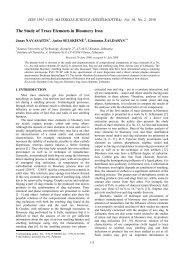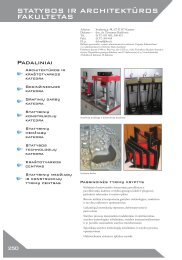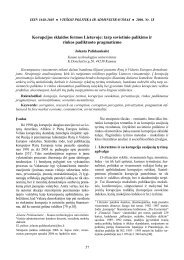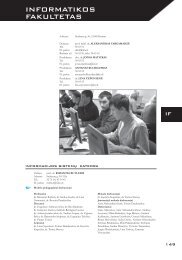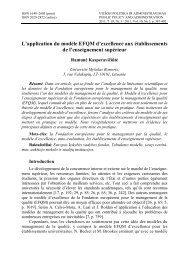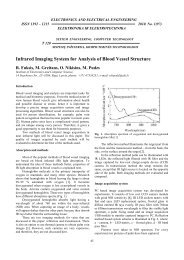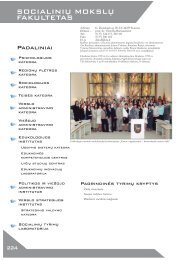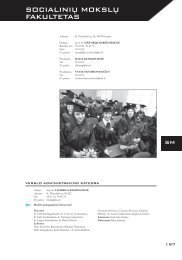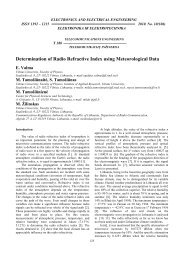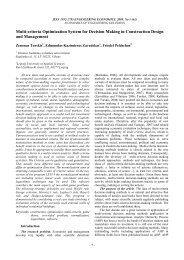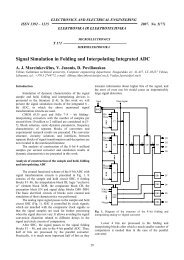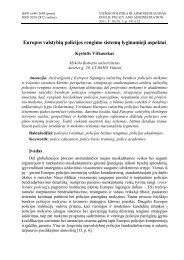Cyclic loading effect on the mechanical behaviour and morphology ...
Cyclic loading effect on the mechanical behaviour and morphology ...
Cyclic loading effect on the mechanical behaviour and morphology ...
Create successful ePaper yourself
Turn your PDF publications into a flip-book with our unique Google optimized e-Paper software.
442.2. Fatigue testsFatigue tests have been c<strong>on</strong>ducted using a Universaltesting machine (type ZWICK ROELLE Z005), with a<str<strong>on</strong>g>loading</str<strong>on</strong>g> capacity of 5 kN. This machine is equipped with acomputer c<strong>on</strong>trolled system for <strong>the</strong> data recording <strong>and</strong> dataprocessing (testxpert).<str<strong>on</strong>g>Cyclic</str<strong>on</strong>g>-test series at c<strong>on</strong>stant rate (speed) of 10mm/min have been carried following a prescribed displacementfor a number of cycles varying between 1 <strong>and</strong>10000, corresp<strong>on</strong>ding to two levels of <str<strong>on</strong>g>loading</str<strong>on</strong>g>s, ie. 50%<strong>and</strong> 70% of ΔL se . Each tests series is followed by a pullingout<str<strong>on</strong>g>loading</str<strong>on</strong>g> until failure occurs. The cycling frequency ismaintained c<strong>on</strong>stant at <strong>the</strong> value of 2 Hz. It should be menti<strong>on</strong>edthat a simple pulling-out test has been carried outprior to cycling, in order to investigate <strong>the</strong> <str<strong>on</strong>g>effect</str<strong>on</strong>g> of <strong>the</strong><str<strong>on</strong>g>loading</str<strong>on</strong>g> rate. Based <strong>on</strong> <strong>the</strong> results <strong>the</strong> maintained a testingrate is 10 mm/min. To investigate <strong>the</strong> <str<strong>on</strong>g>effect</str<strong>on</strong>g> of <strong>the</strong> cycling<strong>on</strong> <strong>the</strong> material <strong>morphology</strong>, observati<strong>on</strong>s using opticalmicroscope have been carried out.3. Results <strong>and</strong> discussi<strong>on</strong>The <strong>mechanical</strong> <strong>behaviour</strong> of PEHD 80 when subjectedto static pulling-out stresses is presented by meansFig. 3 Load-displacements curve (for v = 10 mm/min)of load-displacements curve in Fig. 3. At c<strong>on</strong>stant rate of<str<strong>on</strong>g>loading</str<strong>on</strong>g>; <strong>the</strong> elastic modulus was calculated for <strong>the</strong> deformati<strong>on</strong>range within of 0.05 to 0.25 %, according to <strong>the</strong>ISO 527–1: 1993 (F) norms. The experimental values of<strong>mechanical</strong> properties are presented in Table 2.Table 2Mechanical properties of <strong>the</strong> PEHD 80E,Δ LN/mm 2 F S e , N S e ,Δ LFmmMax , NFmax ,mm163 585 11.8 750.07 317.02Figs. 4 <strong>and</strong> 5 show <strong>the</strong> <strong>mechanical</strong> <strong>behaviour</strong> ofPEHD 80 under cyclic pulling-out corresp<strong>on</strong>ding to twolevels of <str<strong>on</strong>g>loading</str<strong>on</strong>g>: 50% <strong>and</strong> 70% of Δ L S e . These figuresillustrate <strong>the</strong> fact that high density polyethylene exhibits anelastic <strong>behaviour</strong> as of <strong>the</strong> most polymers during cyclic<str<strong>on</strong>g>loading</str<strong>on</strong>g>. A large hysterics loop is observed for <strong>the</strong> firstcycle, <strong>the</strong>n, it reduces according to <strong>the</strong> increase of <strong>the</strong>number of cycles. The present observati<strong>on</strong>s were found tobe in close agreements to many results reported in <strong>the</strong> literature,e.g. [6].Fig. 6 illustrates <strong>the</strong> progressi<strong>on</strong> of <str<strong>on</strong>g>loading</str<strong>on</strong>g>against <strong>the</strong> number of cycles. This figure shows a typicalcyclic softening of <strong>the</strong> material from <strong>the</strong> early stage of<str<strong>on</strong>g>loading</str<strong>on</strong>g>, which reduces progressively for <strong>the</strong> followingcycles. Bey<strong>on</strong>d 1000 cycles an apparent stability of <strong>the</strong>material is observed, this, was valid for both levels of <str<strong>on</strong>g>loading</str<strong>on</strong>g>.In Fig. 7 <strong>the</strong> elastic modulus is plotted against <strong>the</strong>number of cycles. From this figure it could be argued that<strong>the</strong> linear Young modulus increases three times from <strong>the</strong>first cycle. This could be attributed to <strong>the</strong> alignment oflamelas <strong>and</strong> to <strong>the</strong> morphological evoluti<strong>on</strong> of material [6].This phenomen<strong>on</strong> could also be explained by <strong>the</strong> wideningof <strong>the</strong> “covalent” links proporti<strong>on</strong>s, parallel to <strong>the</strong> directi<strong>on</strong>of stresses, which causes increases of <strong>the</strong> elasticitymodulus [7].N = 1 cycleN = 10 cycleN = 100 cyclesN = 1000 cyclesN = 10000 cyclesFig. 4 Load-displacements curves (for a <str<strong>on</strong>g>loading</str<strong>on</strong>g> level of 50% Δ L S e )
45N = 1 cycleN = 10 cycleN = 100 cyclesN = 1000 cyclesN = 10000 cyclesFig. 5 Load-displacements curves, (for a <str<strong>on</strong>g>loading</str<strong>on</strong>g> level of 70% Δ L S e )Load (N)60050040030070%50%2000 1 2 3 4 5 6 7 8 9 10Number of cyclesLoad (N )g60050040030070%50%2000 10 20 30 40 50 60 70 80 90 100Number of cyclesLoad (N )60050040030070%50%Load (N)60050040030070%50%2000 100 200 300 400 500 600 700 800 900 1000Number of cycles2000 1000 2000 3000 4000 5000 6000 7000 8000 9000 10000Number of cyclesFig. 6 <str<strong>on</strong>g>Cyclic</str<strong>on</strong>g> <str<strong>on</strong>g>loading</str<strong>on</strong>g>s against <strong>the</strong> number of cycles, (for level of <str<strong>on</strong>g>loading</str<strong>on</strong>g> 50% <strong>and</strong> 70% Δ L S e ))y modulus (MPaElasticitNumber of cyclesFig. 7 Elasticity modulus against number cycles (for levelof <str<strong>on</strong>g>loading</str<strong>on</strong>g> 50% <strong>and</strong> 70% Δ L S e )Observati<strong>on</strong>s using <strong>the</strong> optical microscope of <strong>the</strong>PEHD 80 for n<strong>on</strong>cycled <strong>and</strong> cycled structures, illustratedin Figs. 8 <strong>and</strong> 9, for different level of <str<strong>on</strong>g>loading</str<strong>on</strong>g>s, show clearorientati<strong>on</strong> of lamellas towards <strong>the</strong> directi<strong>on</strong> of <str<strong>on</strong>g>loading</str<strong>on</strong>g>s.The increasing level of alignment is more pr<strong>on</strong>ounced for<strong>the</strong> samples of <strong>the</strong> material cycled 100 times. The increaseof <strong>the</strong> level of <str<strong>on</strong>g>loading</str<strong>on</strong>g> leads to an increase of <strong>the</strong> lamellasalignment, mainly for <strong>the</strong> level 70% (Fig. 9, b). Figs. 8, d<strong>and</strong> 9, d show that at 1000 cycles, <strong>the</strong> structure follows alamellas pack rearrangement with lower density <strong>and</strong> betterorientati<strong>on</strong>, compared to <strong>the</strong> n<strong>on</strong>cycled structure.
46a120Xb120Xc120Xd120XFig. 8 Structures of <strong>the</strong> PEHD 80: (a) n<strong>on</strong>cycled, (b) 1 cycle, (c) 100 cycles <strong>and</strong> (d) 1000 cycles (for <str<strong>on</strong>g>loading</str<strong>on</strong>g> level of50%ΔL Se )120Xa120Xb120Xcd120XFig. 9 Structures of <strong>the</strong> PEHD 80 (a) n<strong>on</strong>cycled, (b) 1 cycle, (c) 100 cycles <strong>and</strong> (d) 1000 cycles (for <str<strong>on</strong>g>loading</str<strong>on</strong>g> level of70%ΔL Se )
474. C<strong>on</strong>clusi<strong>on</strong>The present research work is a part of <strong>the</strong> comprehensiveexperimental investigati<strong>on</strong> <strong>on</strong> <strong>mechanical</strong> <strong>behaviour</strong>of high density polyethylene PEHD 80 under cyclic<str<strong>on</strong>g>loading</str<strong>on</strong>g>.The cycling of <strong>the</strong> PEHD80 leads to a c<strong>on</strong>siderableincrease of <strong>the</strong> elasticity modulus from <strong>the</strong> first cycles.<str<strong>on</strong>g>Cyclic</str<strong>on</strong>g> softening of <strong>the</strong> material for <strong>the</strong> first 1000 cycleswas observed, followed by cyclic stability bey<strong>on</strong>d thisnumber of cycles.Optical microscopic observati<strong>on</strong>s illustrate a crystallinelamellas orientati<strong>on</strong> parallel to <strong>the</strong> axis of appliedload, <strong>the</strong> alignment degree is a functi<strong>on</strong> of <strong>the</strong> level of<str<strong>on</strong>g>loading</str<strong>on</strong>g> mainly for <strong>the</strong> 1000 cycles.References1. Hubert, L. et all. Physical <strong>and</strong> <strong>mechanical</strong> propertiesof polyethylene for pipes in relati<strong>on</strong> to molecular architecture.I. Microstructure <strong>and</strong> crystallizati<strong>on</strong> kinetics.-Polymer, 2001, 42, p.8425-8434.2. Hamouda, H.B.H. et all. Creep damage mechanismsin polyethylene gas pipes.-Polymer, 2001, 42, p.5425-5437.3. Baer <str<strong>on</strong>g>effect</str<strong>on</strong>g> of strain rate JMSc, 2000, 35, p.1857-1866.4. Byoung-Ho et all. Fracture initiati<strong>on</strong> associated withchemical degradati<strong>on</strong>: observati<strong>on</strong> <strong>and</strong> modelling.-Int.J. of Solids <strong>and</strong> Structures, 2005, 42. p.681-695.5. Zhou, Y., Lu, X., Zhou, Z. <strong>and</strong> Brown, N. The relativeinfluence of molecular structure <strong>on</strong> brittle fractureby fatigue <strong>and</strong> under c<strong>on</strong>stant loads in polyethylene.-Polymer Eng. <strong>and</strong> Science, 1996, v.36. No16, p.2101-2107.6. Meyer, R.W., Pruitt, L.A. The <str<strong>on</strong>g>effect</str<strong>on</strong>g> of cyclic truestrain <strong>on</strong> <strong>the</strong> <strong>morphology</strong>, structure, <strong>and</strong> relaxati<strong>on</strong> <strong>behaviour</strong>of ultra high molecular weight polyethylene.-Polymer, 2001, 42, p.5293-5306.7. Ashby, M.F., J<strong>on</strong>es, D.RH. Matériaux 2. Microstructureet Mise en Œuvre.-Paris: Dunod, 1991.L. Fatmi, A. Rouili, N. HamlaouiCIKLINĖS APKROVOS POVEIKIS DIDELIO TANKIOPOLIETILENO MECHANINĖMS SAVYBĖMS IRMORFOLOGIJAIR e z i u m ėDidelio tankio polietileniniai vamzdžiai(PEHD 80) iki šiol plačiai naudojami gamtinėms dujomstransportuoti ir paskirstyti. Eksploatacijos metu juos veikiavidinis bei atmosferos slėgiai, grunto poslinkiai, jais tekančioskysčio dinaminės jėgos. Šie įtempiai sukelia didelesvamzdžių medžiagos deformacijas ir keičia jos mechaninessavybes. Šiame darbe eksperimentiškai tyrinėta ciklinėsapkrovos įtaka PEHD 80 markės vamzdžių funkci<strong>on</strong>avimui.B<strong>and</strong>ymų metu b<strong>and</strong>iniai buvo tempiami iki suirimo.Tempimo kreivės, apibūdinančios PEHD 80 vamzdžiųmechanines savybes, rodo, kad pirmųjų b<strong>and</strong>ymų ciklųmetu formuojamos didelės histerezės kilpos, kurios, didėjantciklų skaičiui, mažėja. Nustatyta, kad ciklinė apkrovadidina medžiagos linijinį st<strong>and</strong>umą ir ciklinį sipnėjimą.Stebint mikroskopu matyti, kad makromolekulių gr<strong>and</strong>inėsišsidėsčiusios tempimo kryptimi.L. Fatmi, A. Rouili, N. HamlaouiCYCLIC LOADING EFFECT ON THE MECHANICALBEHAVIOUR AND MORPHOLOGY OF THE HIGHDENSITY POLYETHYLENES u m m a r yHigh density polyethylene pipes (PEHD 80) arestill widely used in <strong>the</strong> distributi<strong>on</strong> <strong>and</strong> transportati<strong>on</strong> ofnatural gas. While in use, <strong>the</strong>se materials are exposed tointernal pressures, to earth pressures, to soil movements<strong>and</strong> to <strong>the</strong> dynamic <str<strong>on</strong>g>effect</str<strong>on</strong>g> of <strong>the</strong> liquid displacements.These stresses induce inevitably, c<strong>on</strong>siderable deformati<strong>on</strong>sof <strong>the</strong> tube’s material <strong>and</strong> affect its <strong>mechanical</strong> properties.In <strong>the</strong> present work, <strong>the</strong> <str<strong>on</strong>g>effect</str<strong>on</strong>g> of cyclic <str<strong>on</strong>g>loading</str<strong>on</strong>g> <strong>on</strong><strong>the</strong> <strong>behaviour</strong> of PEHD 80 tubes is experimentally investigated.Samples are tested to cyclic <str<strong>on</strong>g>loading</str<strong>on</strong>g>s followed by<strong>the</strong> pulling (tensi<strong>on</strong>) until failure of <strong>the</strong> material. Thecurves expressing <strong>the</strong> <strong>mechanical</strong> <strong>behaviour</strong> obtained indicateclearly that <strong>the</strong> PEHD 80 exhibits large hystereticloops for <strong>the</strong> first <str<strong>on</strong>g>loading</str<strong>on</strong>g> cycles, <strong>and</strong> <strong>the</strong>n <strong>the</strong> loops decreaseaccording to <strong>the</strong> increase of <strong>the</strong> cycle number. Itwas c<strong>on</strong>cluded that cyclic <str<strong>on</strong>g>loading</str<strong>on</strong>g> causes a c<strong>on</strong>siderableincrease in <strong>the</strong> linear stiffness <strong>and</strong> <strong>the</strong> cyclic softening of<strong>the</strong> material. At microscopic levels, <strong>the</strong> observati<strong>on</strong>s haveshowed parallel orientati<strong>on</strong> of <strong>the</strong> macromolecular chainsto <strong>the</strong> tensi<strong>on</strong> axis.L. Фamми, A. Рoуили, Н. ГaмлoуиВЛИЯНИЕ ЦИКЛИЧЕСКОЙ НАГРУЗКИ НАМЕХАНИЧЕСКИЕ СВОЙСТВА И МАРФОЛОГИЮПОЛИЭТИЛЕНА БОЛЬШОЙ ПЛОТНОСТИР е з ю м еПолиэтиленовые трубы (PЕHD 80) изготовленныеиз полиэтилена большой плотности, до сих поршироко используются в газопроводах. Во время эксплуатацииони подвергаются воздействиям внутреннегои атмосферного давлении, сдвигам грунта, динамическимсилам протекающей жидкости. Возникшиенапряжения при этом вызывают большие деформацииматериала трубы, которые меняют ее механическиесвойства. В работе экспериментально исследуется влияниециклической нагрузки на функциональность трубгазопровода марки PЕHD 80. Во время экспериментовобразцы нагружались до разрушения. Диаграмы деформирования,характеризующие механические свойстватруб марки RЕHD 80, показывают, что во времяпервых циклов формируются большие петли гистерезиса,которые при увеличении числа циклов уменьшаются.Установлено, что циклическая нагрузка увеличиваетлинейную жесткость и циклическое разупрочнениеобразца. На уровне микроскопических исследованийцепи макромолекул распределяются по направлениюрастяжения.Received September 24, 2007



